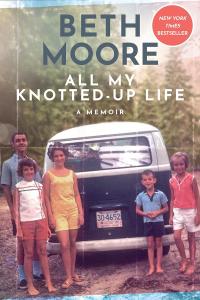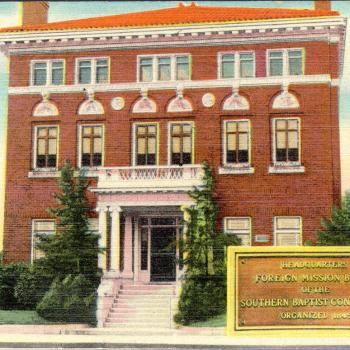 It’s the most wonderful time of the year: the time to buy all your friends and relatives books for Christmas! In that spirit, I am posting here a (non-paywalled) review of one of my favorite reads of the year, Beth Moore’s memoir All My Knotted-Up Life, that I first published at Current. Enjoy! (And buy it for people…)
It’s the most wonderful time of the year: the time to buy all your friends and relatives books for Christmas! In that spirit, I am posting here a (non-paywalled) review of one of my favorite reads of the year, Beth Moore’s memoir All My Knotted-Up Life, that I first published at Current. Enjoy! (And buy it for people…)
I used to look down on Beth Moore. Mind you, I didn’t know anything about her. What I really looked down on was “women’s ministry” in general and the idea of purchased curriculum in particular: Why separate women out? And if you do, why watch a video of a teacher on a stage? A local teacher could bother to study the Bible herself. Of course, I hold a seminary degree.
Then in Spring 2014 I signed up for an evening women’s Bible study. I wanted to meet more people at church and Bible studies were separated by sex. The evening crowd had a day job, so I figured I might have more in common with them. They happened to be doing a Beth Moore study. Specifically, the anniversary version of Beth Moore’s very first published Bible study—on the Tabernacle.
I may be judgmental, but I am also fair-minded. Turns out Beth Moore is an exceptional Bible teacher. I’m grateful I had this realization as background for the events of 2016 that put her on an even bigger stage, for different reasons.
Those events constitute the context of her memoir, the “why now.” In brief, Beth Moore was a beloved Bible teacher to many, many evangelical women, especially to those in her own beloved Southern Baptist Convention. And then she wasn’t. Her crime? Calling out the evangelical men who defended Trump after he bragged about sexual assault on the Access Hollywood tapes.
All My Knotted-Up Life reads like a novel, complete with foreshadowing and callbacks. Because that is how Moore understands her life: an apparently chaotic story scripted by the hand of a loving Author. For the same reason, Moore writes about herself and others with both clear-eyed honesty and compassion.
Eight of its twenty-two chapters focus on Moore’s upbringing. Here we find the origins of some of the things for which she is most famous—for starters, her deep Arkansas expressions. My personal favorite, about someone denying the truth: “I knew he was lying like a plump cat on a warm windowsill.” Also, not surprisingly, her commitment to the Southern Baptist Convention. SBC churches were her harbor in the storm of her tumultuous upbringing.
Less well-known, that tumultuous upbringing itself. Moore had previously alluded to her experience of sexual abuse. As a result, countless women confided to her the same. Here we learn the perpetrator was her father.
She treats this part of her narrative with the sensitivity of a sexual abuse survivor: Rather than discuss his actions in any detail, she writes about how it affected her, using the recurring metaphor of the storm. She also writes about how life with her father affected her mother, which in turn affected the children. Her mother suffered a mental break at exactly the time Beth needed her the most. Beth would later suffer a similar break for about a year in her thirties, when the inner dam holding back the storm’s accumulated floodwater finally burst.
The heart of the book starts with a chapter on her call to ministry followed by a chapter on her marriage to Keith. The tangled but verdant life that follows grows from these two seeds, both planted during her college years. Unlike Beth, neither species fell within the Southern Baptist genus.
While serving as a church camp counselor, one day Beth experienced the overwhelming presence of God at the cabin bathroom sink. Despite the rarity of charismatic experiences in SBC circles at the time, she and her mentors interpreted this event as a call to “work for God” in some capacity. Her options as a Southern Baptist woman in the 1980s were missionary or teacher of women or children.
A few years later, Beth married cradle-Catholic cussing Keith rather than her clean-cut high school boyfriend from a Leave it to Beaver church family. She had been too afraid to share her real background with a man whose life seemed perfect. That, and she fell madly in love with Keith and he with her. He supported her working for God—if she didn’t become a nun.
Keith’s life was very much not perfect. At age two, he and his three-year-old brother accidentally ignited a fire in their garage. He made it out alive, his brother didn’t. Emotionally, he would live with PTSD and bipolar disorder that colored his life even more than sexual abuse colored Beth’s.
Beth subsequently experienced two more clarifying calls to ministry, one external and one internal. On-brand for her personality—and her hair—Beth led a church aerobics ministry. After speaking at a women’s event on “Making Fitness Count for Christ,” one of the SBC’s very few prominent women’s speakers suggested that Beth might be fit to join their ranks. Soon, Moore realized that motivational speaking only helps people grow so far. She experienced God calling her to attend a substantive Bible study. On Day One the (male) teacher’s obvious love for God’s Word sparked a flame of longing within her to go and be likewise. Years only fanned it higher and higher.
Meanwhile, she gave birth to her beloved daughters. Here is Moore: “I wanted two things desperately. I wanted my family, and I wanted ministry. I wanted to raise my own children. I also wanted women to catch a fever for the Scriptures. I loved being home, and I loved being on the road. I adored my two little girls, and I also adored cracking open a Bible with a room full of females.”
She got both. Moore narrates the founding and growth of her Living Proof Ministries and its partnership with Lifeway, the SBC’s publishing arm. Together they produced nearly twenty women’s Bible studies and completely packed multiple arenas. Simultaneously, Moore maintained close, warm relationships with her husband and daughters that continue to this day.
Of particular interest to me as a historian of gender, religion, and higher education is that Moore narrates her training for teaching thousands upon thousands of women. When she first set her hand to the plow, she sought out a seminary degree at the Houston branch of Southwestern Baptist Theological Seminary. In the memoir, she credits her decision not to return for a second semester to the fact that it did not offer courses compatible with her children’s school hours. Elsewhere she has added that the temperature there for women was not the warmest. Either way, the SBC did not at the time prioritize equipping women to teach.
So Moore prioritized equipping herself. She got tutoring in Greek. She secured a few more formal classes. Most significantly, she purchased or borrowed every Bible commentary she could find that believed in the divine inspiration and authority of the Scriptures and “that Jesus Christ is the Son of God and very God who came in the flesh and, though he knew no sin, was crucified for our sins, raised from the dead, ascended to God’s right hand, and will one day return.” She also read rabbis such as Abraham Joshua Heschel. The result of her training was deep and broad historic Christian orthodoxy, but decidedly not a purebred Southern Baptist outlook.
Her sex and her non-traditional education made her less than welcome among some denominational movers and shakers. But so long as she bowed to male leadership—literally, she tried to make herself shorter around short men—she kept her ministry.
Her rapid descent from popularity when she finally stood up straight caused Moore to become a historian of her own life. The final chapters of the book, about the upheavals since 2016, start with a history of politics and gender within the Southern Baptist Convention since the 1980s. Alongside this history she places her own, which both tracks and defies it.
This uneasy pairing is the value of history to memoir, and memoir to history. Moore’s individual story only makes sense in the wider context of the history of politics and gender in both the USA and the SBC. At the same time, her individual story does not reduce her to mere pawn of social forces; it demonstrates, rather, one’s ability to choose.
Noting that beliefs about gender and race often intertwine, Moore makes a good faith effort to grapple with the role of racism in her life, from Arkansas to Texas to the SBC. The narrative fit is awkward at times, but perhaps that’s fitting for a Southern white woman. Always touched by the realities of race, and never graced with an easy life herself, Moore nevertheless had the privilege of not making those questions central—until she found herself marginalized in a way similar to her Black brothers and sisters.
Moore had always embraced Southern Baptist “complementarian” gender theology. After all, her pastor and his wife modeled a healthy marriage. But also, the thought that male headship in home and church might not be Scripture’s intent simply never occurred to her because it would mean forfeiting her ministry within the SBC.
Still, it caused strain. Beth and Keith were not the traditional Southern Baptist couple. Keith did not care to participate in church life beyond attendance (when it wasn’t deer season). But he actually supported her calling so much that, to honor her interpretation of “male covering,” he always prayed for her before she taught. Even at a whisper, in a deer blind.
Meanwhile, many male denominational leaders were straight-up mean to Moore. At SBC events at which both spoke, they refused to talk to her backstage and ridiculed her onstage. She excused it at the time as a combination of her lesser formal education and their different, but honest, interpretation of complementarian theology. She thought they were attempting to be faithful to God’s Word, and just missing the mark a bit.
She was wrong. Criticizing Trump’s defense of sexual assault and evangelicals’ defense of his comments led to a barrage of hate calls, hate mail, and hate tweets. Pro-life herself (“though I lacked the guts to be overly pious about it because it’s a wonder I hadn’t ended up with an unwanted pregnancy”), Moore understood the political complexities. She also understood the ties between the Southern Baptist “Conservative Resurgence” and the Religious Right. On balance, she concluded: “All this time, I’d accepted the rampant sexism because I thought it was about Scripture. . . . [But this did not] evidence fruit of the Holy Spirit. . . . [This] was about power. This was about control. This was about the boys’ club. You lied.”
Things would only get worse two years later when Moore delivered the sermon at an SBC church on Mother’s Day. The SBC was reckoning with a recent exposé of how some denominational leaders had knowingly covered up sexual abuse, with survivors numbering in the hundreds. Suddenly, Southern Baptist leaders were more concerned with whether a woman occasionally preaching violated biblical gender roles than whether a man assaulting women and children did.
During these exact years, roughly 2015 through 2020, a vicious bacterial infection left Keith physically and psychologically incapacitated. Beth endured all of these attacks without her husband’s support. Indeed, she feared that she had lost him forever. It’s enough to make even the skeptical believe in spiritual warfare.
Finally, Moore left the denomination that had been her home, her family, her haven from the storm. But she did not leave Jesus.
And, she notes, Jesus did not leave her: “I needed neatness from God. What I got was a tangled-up knot. . . . [but] in all the bruising and bleeding and sobbing and pleading, my hand has been tightly knotted, safe and warm, with the hand of Jesus. In all the letting go, he has held me fast.”
As Beth tells it, her story belongs equally to Keith, with whom she shares her tightest earthly knot. The book closes with two ways their spiritual lives have become more tightly intertwined since leaving the SBC. First, they ended up at an Anglican church: a mixture of the Catholic forms of Keith’s childhood and the evangelical theology of Beth’s. Both find nourishment there and love attending together.
The second story, about their house, I won’t spoil. Moore perceives both chaos and order in her life, the latter plotted patiently by her Lord. It would be easy to read such order into our lives. But narrative flourishes of this kind would be difficult for us to concoct, and especially to time.
One thing stood out to me from Moore’s Tabernacle study: The Israelites could not store manna overnight; it would rot. They had to gather new manna every morning. Consequently, Moore got up every day before dawn to spend time in Bible reading and prayer, to receive her daily bread from Jesus’ hand. And she has yet to stop, throughout all her knotted-up life.
These days, many mornings she shares what she has learned on Twitter. Sometimes she calls out sin in the church, but her tweets overwhelmingly concern not what she is against, but what she is for: Jesus. They emanate love for him and confidence in him and desire for others to know him too.
Beth doesn’t know me from Eve, to borrow her repeated phrase, but my review copy was signed: “To Andrea— I’m honored to share these pages with you. My prayer is that something of my story will enrich something of the reader’s story. With love, Beth.”
It has, Beth. Thank you.













